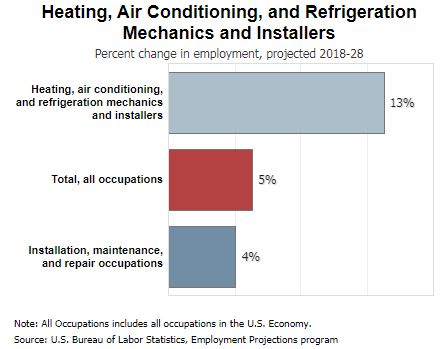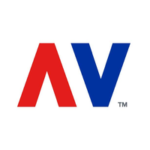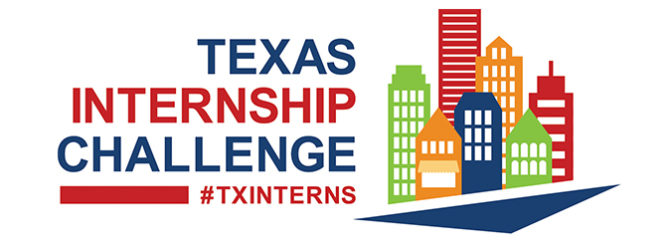HVAC Mechanic
Heating, air conditioning, and refrigeration mechanics and installers work on heating, ventilation, cooling, and refrigeration systems. Because HVACR systems have become increasingly complex, employers generally prefer applicants with post-secondary education or those who have completed an apprenticeship. Some states and localities may require technicians to be licensed.
| Quick Facts: Heating, Air Conditioning, and Refrigeration Mechanics and Installers | |
|---|---|
| 2018 Median Pay | $47,610 per year $22.89 per hour |
| Typical Entry-Level Education | Postsecondary nondegree award |
| Work Experience in a Related Occupation | None |
| On-the-job Training | Long-term on-the-job training |
| Number of Jobs, 2018 | 367,900 |
| Job Outlook, 2018-28 | 13% (Much faster than average) |
| Employment Change, 2018-28 | 46,300 |
Heating, air conditioning, and refrigeration mechanics and installers—often called HVACR technicians—work on heating, ventilation, cooling, and refrigeration systems that control the temperature and air quality in buildings.
Duties
Heating, air conditioning, and refrigeration mechanics and installers typically do the following:
- Install, clean, and maintain HVACR systems
- Install electrical components and wiring
- Inspect and test HVACR systems and components
- Discuss system malfunctions with customers
- Repair or replace worn or defective parts
- Recommend maintenance to improve system performance
- Keep records of work performed
Heating and air conditioning systems control the temperature, humidity, and overall air quality in homes, businesses, and other buildings. By providing a climate-controlled environment, refrigeration systems make it possible to store and transport food, medicine, and other perishable items.
Some HVACR technicians specialize in one or more specific aspects of HVACR, such as radiant heating systems, solar panels, testing and balancing, or commercial refrigeration.
When installing or repairing air conditioning and refrigeration systems, technicians must follow government regulations regarding the conservation, recovery, and recycling of refrigerants. The regulations include those concerning the proper handling and disposal of fluids and pressurized gases.
Some HVACR technicians sell service contracts to their clients, providing periodic maintenance of heating and cooling systems. The service usually includes inspecting the system, cleaning ducts, replacing filters, and checking refrigerant levels.
Other workers sometimes help HVACR technicians install or repair cooling and heating systems. For example, on a large air conditioning installation job, especially one in which workers are covered by union contracts, ductwork may be installed by sheet metal workers, electrical work by electricians, and pipework by plumbers, pipefitters, and steamfitters. Boiler systems are sometimes installed by a boilermaker.
Home appliance repairers usually service window air conditioners and household refrigerators.
Heating, air conditioning, and refrigeration mechanics and installers held about 367,900 jobs in 2018. The largest employers of heating, air conditioning, and refrigeration mechanics and installers were as follows:
| Plumbing, heating, and air-conditioning contractors | 64% |
| Self-employed workers | 9 |
| Retail trade | 3 |
| Educational services; state, local, and private | 3 |
| Wholesale trade | 3 |
HVACR technicians work mostly in homes, schools, stores, hospitals, office buildings, or factories. Some technicians are assigned to specific jobsites at the beginning of each day. Others travel to several different locations, making service calls.
Although most technicians work indoors, some may have to work on outdoor heat exchangers, even in bad weather. Technicians often work in awkward or cramped spaces, and some work in buildings that are uncomfortable because the air conditioning or heating system is not working properly.
Injuries and Illnesses
HVACR technicians have one of the highest rates of injuries and illnesses of all occupations. Potential hazards include electrical shock, burns, muscle strains, and injuries from handling heavy equipment.
Appropriate safety equipment is necessary in handling refrigerants, because they are hazardous and contact can cause skin damage, frostbite, or blindness. When working in tight spaces, inhalation of refrigerants is also a potential hazard. Several refrigerants are highly flammable and require additional care.
Work Schedules
The majority of HVACR technicians work full time. Evening or weekend shifts may be required, and HVACR technicians often work overtime or irregular hours during peak heating and cooling seasons.
Because HVACR systems have become increasingly complex, employers generally prefer applicants with postsecondary education or those who have completed an apprenticeship. Some states and localities may require technicians to be licensed. Workers may need to pass a background check prior to being hired.
Education
Many HVACR technicians receive postsecondary instruction from technical and trade schools or community colleges that offer programs in heating, air conditioning, and refrigeration. These programs generally last from 6 months to 2 years and lead to a certificate or an associate’s degree.
High school students interested in becoming an HVACR technician should take courses in vocational education, math, and physics. Knowledge of plumbing or electrical work and a basic understanding of electronics is also helpful.
Training
New HVACR technicians typically begin by working alongside experienced technicians. At first, they perform basic tasks such as insulating refrigerant lines or cleaning furnaces. In time, they move on to more difficult tasks, including cutting and soldering pipes or checking electrical circuits.
Some technicians receive their training through an apprenticeship. Apprenticeship programs usually last 3 to 5 years. Over the course of the apprenticeship, technicians learn safety practices, blueprint reading, and how to use tools. They also learn about the numerous systems that heat and cool buildings.
Several groups, including unions and contractor associations, sponsor apprenticeship programs. Apprenticeship requirements vary by state and locality.
Licenses, Certifications, and Registrations
The U.S. Environmental Protection Agency (EPA) requires all technicians who buy, handle, or work with refrigerants to be certified in proper refrigerant handling. Many trade schools, unions, and employer associations offer training programs designed to prepare students for the EPA certification exam.
In addition, some states and localities require HVACR technicians to be licensed; check with your state and locality for more information.
Important Qualities
Customer-service skills. HVACR technicians often work in customers’ homes or business offices, so it is important that they be friendly, polite, and punctual. Repair technicians sometimes deal with unhappy customers whose heating or air conditioning is not working.
Detail oriented. HVACR technicians must carefully maintain records of all work performed. The records must include the nature of the work performed and the time it took, as well as a list of specific parts and equipment that were used.
Math skills. HVACR technicians need to calculate the correct load requirements to ensure that the HVACR equipment properly heats or cools the space required.
Mechanical skills. HVACR technicians install and work on complicated climate-control systems, so they must understand the HVAC components and be able to properly assemble, disassemble, and, if needed, program them.
Physical stamina. HVACR technicians may spend many hours walking and standing. The constant physical activity can be tiring.
Physical strength. HVACR technicians may have to lift and support heavy equipment and components, often without help.
Time-management skills. HVACR technicians frequently have a set number of daily maintenance calls. They should be able to keep a schedule and complete all necessary repairs or tasks.
Troubleshooting skills. HVACR technicians must be able to identify problems on malfunctioning heating, air conditioning, and refrigeration systems and then determine the best way to repair them.
The median annual wage for heating, air conditioning, and refrigeration mechanics and installers was $47,610 in May 2018. The median wage is the wage at which half the workers in an occupation earned more than that amount and half earned less. The lowest 10 percent earned less than $29,460, and the highest 10 percent earned more than $76,230.

In May 2018, the median annual wages for heating, air conditioning, and refrigeration mechanics and installers in the top industries in which they worked were as follows:
| Wholesale trade | $51,050 |
| Educational services; state, local, and private | 50,740 |
| Retail trade | 47,520 |
| Plumbing, heating, and air-conditioning contractors | 46,040 |
Apprentices usually earn about half of the wage paid to experienced workers. As they learn to do more, their pay increases.
The majority of HVACR technicians work full time. Evening or weekend shifts may be required, and HVACR technicians often work overtime or irregular hours during peak heating and cooling seasons.

Employment of heating, air conditioning, and refrigeration mechanics and installers is projected to grow 13 percent from 2018 to 2028, much faster than the average for all occupations.
Commercial and residential building construction is expected to drive employment growth. The growing number of sophisticated climate-control systems is also expected to increase demand for qualified HVACR technicians.
Repair and replacement of HVACR systems is a large part of what technicians do. The growing emphasis on energy efficiency and pollution reduction is likely to increase the demand for HVACR technicians as climate-control systems are retrofitted, upgraded, or replaced entirely.
Job Prospects
Job opportunities for HVACR technicians are expected to be good. Candidates familiar with tablet computers and electronics, as well as those who have developed troubleshooting skills, will have the best job prospects.
Technicians who specialize in new installation work may experience periods of unemployment when the level of new construction activity declines. Maintenance and repair work, however, usually remains relatively stable. Business owners and homeowners depend on their climate-control or refrigeration systems year round and must keep them in good working order, regardless of economic conditions.

Bureau of Labor Statistics, U.S. Department of Labor, Occupational Outlook Handbook, Heating, Air Conditioning, and Refrigeration Mechanics and Installers,
on the Internet at https://www.bls.gov/ooh/installation-maintenance-and-repair/heating-air-conditioning-and-refrigeration-mechanics-and-installers.htm (visited October 25, 2019).
Salary information comes from the Bureau of Labor Statistics, Occupational Employment Statistics Program, a semi-annual survey that provides wage and employment statistics for the nation, each state, and sub-state regions.
Tagged as Adam's Air, Air Conditioning, Amarillo College, Amarillo Texas, Apprenticeship, Bulletproof, Career, Education, Frank Phillips College, Heating, Hometown Success, HVAC, Installer, Internships, Jobs Ya'll, Life/Work Balance, Mechanic, Occupation, Pierce Price, Region 16, Texas, Texas Panhandle, Texas Workforce Commission, Ventilation, Workforce Solutions Panhandle, Wrestler, Wrestling.
Written by Phillip












